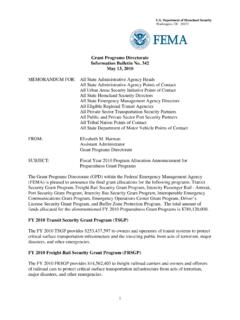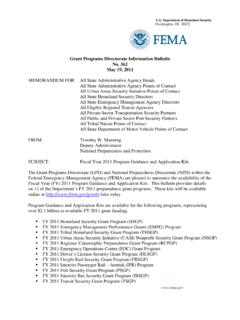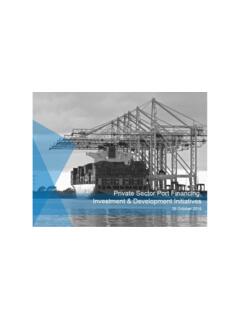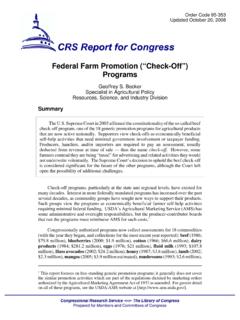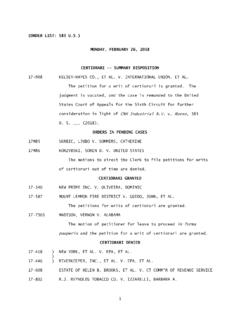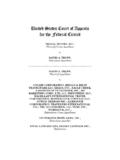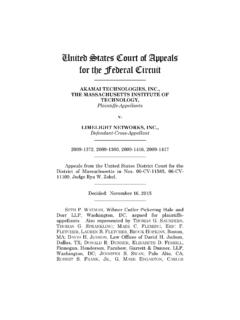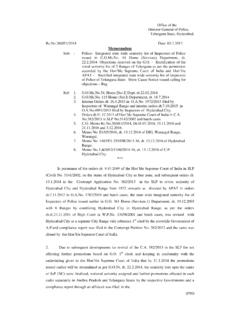Transcription of The Duty Drawback Coalition - Results Direct
1 The duty Drawback Coalition499 South Capitol Street, Suite 600 Washington, 20003 Working to preserve export promotion programs for manufacturers and workers. _____ June 12, 2017 PUBLIC DOCUMENT (filed electronically via ) The Honorable Robert Lighthizer united states Trade Representative 600 17th Street, Washington, 20006 Re:NAFTA Negotiations Written Comments Requests for Comments on Negotiating Objectives Regarding Modernization of the North American Free Trade Agreement with Canada and Mexico, 82 Fed. Reg. 23699 (May 23, 2017), Docket No. USTR-2017-0006 Dear Ambassador Lighthizer: The duty Drawback Coalition1 (the Coalition ) submits these comments to assist the Trade Policy Staff Committee ( TPSC ) as it develops negotiating objectives regarding the modernization of the North American Free Trade Agreement ( NAFTA ).
2 In short, aside from having broad support by manufacturers and exporters, the removal or elimination of the NAFTA Article 303 restrictions over use of duty Drawback and duty deferral export promotion programs (1) will help to reduce the trade deficit with both Canada and Mexico by increasing exports and making them more competitive in those two markets, (2) will help to update and modernize NAFTA, making it consistent with all other Free Trade Agreements ( FTAs ) entered into subsequent to the Chile FTA to ensure that our manufactures, exporters and workers are given every tool in the free trade tool box available to them to promote exports, and (3) has bi-partisan support by Members of Congress recognizing these Drawback is the incremental driver of exports, and the program does not work and refunds of import duties, taxes, and fees are not granted without a export.
3 1 See Exhibit 1, List of Members of The duty Drawback Coalition . 2 See Exhibit 2-3, Letters from Members of Congress to USTR sent in December 2016 and immediately after Ambassador Lighthizer was confirmed this year. Also attached as Exhibit 4 is a September 4, 2003 letter from Members of Congress to USTR, Commerce, and Treasury supporting duty Drawback and deferral programs. Page 2 Summary The modernization of NAFTA and any free trade agreement ( FTA ) necessarily entails, among other things, repeal of the current duty Drawback and deferral restrictions for manufacturers and These restrictions dating back to 1994 were intended to prevent non-NAFTA countries from using Canada or Mexico as an export platform for component parts for the manufacture of goods to be exported to the But this concern would never be realized and, to the contrary, the empirical evidence coupled with sidestep measures by Canada and Mexico to avoid the restrictions has encouraged the creation of export platforms to the Direct detriment of manufacturers and exporters.
4 Altogether, the restrictions place manufacturers at a substantial disadvantage as compared to foreign competitors when exporting products to Canada or Mexico. The duty Drawback and deferral restrictions in NAFTA should be repealed to place manufacturers on a level playing field with their foreign competitors and to facilitate free Furthermore, if the Trans Pacific Partnership does move forward without the , and this Administration does not negotiate the elimination of Article 303 of NAFTA during the renegotiation process, then all of our manufacturers, exporters and workers will be at a significant competitive disadvantage versus the TPP countries because those foreign manufacturers and exporters will have the benefit of zero duties when exporting to Canada and Mexico.
5 Plus they will receive the duty Drawback and deferral benefits of their countries programs, while our manufacturers, exporters and workers will be crippled by Article 303 if it is left in place. Drawback duty Drawback was established by the First Session of the First Congress in 1789 to support manufacturers and exporters. duty Drawback allows for the refund of Customs duties, taxes, and fees paid on imported goods that are used as inputs in the production of manufactured products that are later exported, or where the imported good is substituted for the same or similar good that is later This allows manufacturers and exporters to reduce the cost of inputs, and thus reduce manufacturing costs to remain competitive in pricing their exported goods.
6 Manufacturers operating in foreign trade zones (considered outside of Customs territory) can use duty deferral to defer the payment of import duties, taxes and fees on imported foreign component parts or raw materials until those goods or the finished product incorporating those goods are entered into the market for consumption. If such goods are never entered for consumption, but rather exported, the duties, taxes and fees are not paid. In either situation, 3 The Coalition s comments are specifically addressed to the matters identified in Parts 2.(a)-(c)(2), (d)-(e), (k), and (o) of USTR s notice published in the Federal Register. See Requests for Comments on Negotiating Objectives Regarding Modernization of the North American Free Trade Agreement with Canada and Mexico, 82 Fed.
7 Reg. 23699-700 (May 23, 2017). 4 Exhibit 5 are the Coalition s public comments to Commerce relating to recommendations for reduction in regulatory burdens on manufacturers. 5 See 19 1313. Page 3 its gives a cost of production and pricing advantage to manufacturers competing in the global market. duty Drawback and duty deferral are not unique to the united states . In fact, duty Drawback and deferral regimes are utilized by most countries around the world, including all nations that were included in the Trans-Pacific Partnership and NAFTA. duty Drawback is the last remaining export promotion program allowed by the World Trade Organization (WTO). Intent of Drawback The policy rationale supporting duty Drawback is as simple as it is powerful: to increase the competitiveness of manufacturers that export and to create and maintain jobs.
8 Congress stated the rationale for duty Drawback : The purpose of [ duty Drawback ] is to permit American-made products to compete more effectively in world markets. It enables domestic manufacturers .. to select the most advantageous sources for their raw materials and component requirements without regard to duties, thereby permitting savings in their production costs. It also encourages domestic production and, as a result, the utilization of American labor and capital. 6 The Customs Service recognizes that the Drawback program was initiated to create jobs and encourage manufacturing and exporting: Historically, the word Drawback has denoted a situation in which the duty or tax, lawfully collected, is refunded or remitted, wholly, or partially, because of a particular use made of the commodity on which the duty or tax was collected.
9 Drawback was initially authorized by the first tariff act of the united states in 1789. Since then, it has been part of the law, although from time to time the conditions under which it is payable have changed. The rationale for Drawback has always been to encourage American commerce or manufacturers to compete in foreign markets without the handicap of including costs, and 6 Committee on Ways and Means House of Representatives, WMCP 111-6, Overview and Compilation of Trade Statutes 84 (2010 ed.), available at /pkg/CPRT-111 WPRT63130/ Page 4 consequently in his sales price, the duty paid on imported merchandise. 7 Further, below are additional excerpts from various sources revealing the intent behind duty Drawback : Customs Ruling Letter HQ 227994 A review of the legislative history to the Drawback laws, with respect to exportation, shows that the object of the Drawback laws was to build up an export trade.
10 Specifically, the following statements leave no doubt regarding the purpose of the Drawback provisions: By way of encouraging exportation to other countries and extending our markets, the committee have liberalized the drawbacks given upon articles or products imported from abroad and used in manufactures here for the export trade. We have also extended the Drawback provision to apply to all articles imported which may be finished here for use in the foreign market. Heretofore this privilege was limited. This, it is believed, will effectually dispose of the argument so often made that our tariff on raw materials, so called, confines our own producers to their own market and prevents them from entering the foreign market, and will furnish every opportunity to those of our citizens desiring it to engage in the foreign trade.






